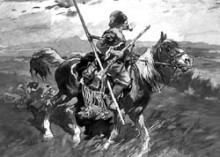Geographical factors are among those affecting the shaping of nation and state building. To the Ukrainians, it was their country’s location toward the end of the great Eurasian steppe route, starting in Mongolia and on through the corridor between the Altai and Tian Shan Mountains, between the Caspian Sea and Urals, reaching the steppes by the Black Sea and stopping only at the foot of the Carpathians. From the outset this area faced the Ukrainian nation and its state system with raids by nomads constantly moving in from the east.
The Antes were the first federation of Eastern Slavs, formed in the second part of the fifth century. They withstood the powerful onslaught of the Goths but lost their chief Boh and seventy elders. Later, they were defeated by the Avars coming across the steppe from the east and setting up their state in Pannonia. The Antean federation ceased to exist because of wars with the Avars (568-635).
Sometime in the period the south steppes saw another aggressor from the east, the Khazars. Their empire, the khaganate, was located between the Sea of Azov and the Caspian Sea, in the lower reaches of the Don and Volga rivers. In the eighth century it won power over the Eastern Slavic tribes of Radymychy, Viatychy, Poliane, and Siveriane, which would from then on pay them tribute until the ninth century. The people of Rus’, after ridding themselves of the Khazar tribute with the help of Prince Oleh, still faced the threat from the steppe (and they had actually had a hand in making it worse).
New steppe nomads, the Pechenegs, appeared in Rus’ in 915, but it was a test of strength rather than war; the Pechenegs could not resort to full-scale hostilities because of the Khazars all set to protect their eastern frontiers. Ironically, the Pechenegs were assisted by allies as the militant Prince Sviatoslav rose in arms in 965. The khaganate could not fight on two fronts and fell apart, opening the road to the north Pontic steps. Sviatoslav made a new horrifying entry in the annals of Kyiv Rus’ as the south steppes had turned into the Dike Pole (Wild Steppe), and the prince could see that it was so before being killed by those same Pechenegs in 972, after an abortive campaign against the Byzantine Empire. Already in 968 the Pechenegs had not only raided and plundered Rus’ borderlands but even besieged the capital, Kyiv.
In 993, the Pechenegs laid waste the territory of Pereyaslav — legend attributes the place name to that campaign (pereyaslav is the Slavonic for taking over someone’s glory, an allusion to a duel in which a Rus’ warrior killed his Pecheneg adversary). In 997, the nomads besieged Bielhorod. After Prince Sviatopolk the Accursed started fighting for the Kyiv throne in 1018, Rus’ princes regularly enlisted Pecheneg support in their internecine feuds; their “allies” would ravage lands on joint campaigns with Rus’ princes the way the Pechenegs did during their own nomadic raids. Sviatopolk brought the Pechenegs to Rus’ again in 1020 as he battled Prince Yaroslav on the Alta River. However, the Pechenegs would not bother Ukrainian territories for long, just slightly over a hundred years. Their last visit took place in 1036 and once again they got as far as Kyiv but were defeated by Yaroslav the Wise who commemorated the victory by founding the St. Sophia Cathedral.
A new enemy appeared in 1055, the Polovetsians, except that this time Prince Vsevolod of Pereyaslav paid them off. In 1062, the Polovetsians invaded the Pereyaslav territory again, overcame Vsevolod, and laid the land waste. In 1068, they defeated three sons of Yaroslav and ravaged the Kyiv territory.
In 1078, Oleh and Borys, sons of Sviatoslav, sided with the Polovtsians and fought their uncle Vsevolod, to get back their father’s lands, thus continuing the ignominious tradition of enlisting southern nomads in the internecine warfare, started by Sviatopolk the Accursed. Oleh brought the Polovetsians to Rus’ again in 1094, as Chernihiv was besieged with Vladimir Monomakh, then prince of Chernihiv. His son Vsevolod would follow the same road in the first half of the twelfth century, fighting his uncle Yaroslav, son of Sviatoslav. Under Yaropolk Monomakh, the Polovetsians twice raided and ravaged Kyiv’s outskirts as allies of Oleh’s sons. The most outrageous events took place in 1169 and 1203, when the Polovtsians were invited by Andrei Bogoliubsky and Rurik Rostyslavych to help destroy Kyiv. The last time the Polovtsians appeared as bidden by Iziaslav, son of Mstyslav, and ravaged Kyiv during his struggle for the throne with Volodymyr Rurik in 1234.
Polovetsian involvement in the internecine feud was only a small part of their operations in Kyiv Rus’, as they mostly raided the lands of their own free will almost every year. What the Polovetsians and their chiefs were like is obvious from folk tales and chronicles. Thus, Khan Boniak is described as a “ruthless and godless monster in human form”; Khan Konchak as “godless, accursed, and forever damned.” The Polovetsians, however, were not destined to shout the last hurrah in destroying the medieval Ukrainian state system. Another, most formidable eastern aggressor, the Horde, did by destroying Kyiv in 1240.
By the end of the fifteenth century, with the Ukrainian territories going to the Polish-Lithuanian crown and formation of the Crimean khanate, the political situation changed and foundations were laid for new, even more horrifying ordeals. The first sign was the Tatar raid of the Kyiv and Volyn territories, following the defeat of Grand Lithuanian Duke Vytautas in the Battle of the Vorskla River (Aug. 12, 1399). True horror for Ukraine began on September 1, 1489, when Crimean Khan Mengli Giray seized Kyiv as an ally of Ivan III of Muscovy in his campaign against Lithuania. From then on the Crimean Tatars, almost annually raided the Ukrainian lands in the sixteenth and seventeenth centuries, either as Moscow’s allies or acting on their own, or due to other reasons. Unlike the Polovetsians, the Tatars cared not only about Kyiv, Chernihiv, Pereyaslav, and Novhorod-Siversky, but also the rest of the Ukrainian territories, including Volyn, Podillia, Halychyna, and Chelm; they even planned to get into White Russia. The overall situation is apparent from a complaint filed by the Volyn boyars and dated 1545: “Whether or not under truce with the Tatars, we seldom have time to dismount...”
While the princes of Kyiv Rus’ tried to resist the Wild Steppe and even organized raids of nomadic camps — and often personally led them — the Polish government offered no practical resistance after the Ukrainian lands went to the Polish crown. Now the Ukrainian populace had to defend themselves. They had some experience from history and this was one of the reasons for the emergence of the Cossacks.
Cossacks are first mentioned in 1492, shortly after Kyiv fell to Mengli Giray. The first Cossack campaign is mentioned in 1493. A Cossack encampment appeared at the Dnipro rapids in the 1550s, subsequently to become the main Cossack venue and go down in history as the Zaporozhzhian Sich. In other words, the Ukrainian people developed an immunity against all threats to its national existence at the turn of the sixteenth century, owing to the Tatar inoculation, and that immunity was embodied by the Ukrainian Cossacks. They grew and matured in the sixteenth and seventeenth centuries while fighting the Tatars and other enemies. In the mid- seventeenth century they had become precisely that force which, at that turning point in world history, after the Thirty Years’ War (1618- 48), found new ways to develop Ukrainian history, reviving Ukrainian statehood in the new epoch. The Cossacks, however, not only continued the Ukrainian state-building tradition (cut short in the fourteenth century, but also laid the foundations of the Ukrainian nation in the seventeenth and eighteenth centuries. It was also then that the true Cossack character formed; its is still alive and is the basis of Ukrainian identity.
And so the Wild Steppe that for a number of centuries refused to leave the Ukrainians in peace also did much to ruin the Ukrainian statehood in the Middle Ages, but then became a catalyst of national awakening and revival in the new epoch. Evidence is found in the history of the Belarus who found themselves in a similar situation after the Golden Horde, evolving as part of the Polish Kingdom, yet without the steppe nomads constantly threatening their borders. This resulted in the absence of a social stratum prepared to protect their national revival to the last man in the new epoch and in the years to come. In a word, but for the Wild Steppe, Ukraine might not have appeared at all.







